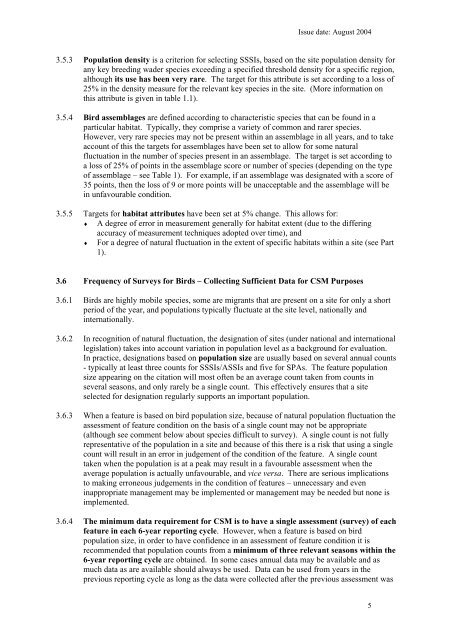Common Standards Monitoring guidance for birds - JNCC
Common Standards Monitoring guidance for birds - JNCC
Common Standards Monitoring guidance for birds - JNCC
Create successful ePaper yourself
Turn your PDF publications into a flip-book with our unique Google optimized e-Paper software.
Issue date: August 2004<br />
3.5.3 Population density is a criterion <strong>for</strong> selecting SSSIs, based on the site population density <strong>for</strong><br />
any key breeding wader species exceeding a specified threshold density <strong>for</strong> a specific region,<br />
although its use has been very rare. The target <strong>for</strong> this attribute is set according to a loss of<br />
25% in the density measure <strong>for</strong> the relevant key species in the site. (More in<strong>for</strong>mation on<br />
this attribute is given in table 1.1).<br />
3.5.4 Bird assemblages are defined according to characteristic species that can be found in a<br />
particular habitat. Typically, they comprise a variety of common and rarer species.<br />
However, very rare species may not be present within an assemblage in all years, and to take<br />
account of this the targets <strong>for</strong> assemblages have been set to allow <strong>for</strong> some natural<br />
fluctuation in the number of species present in an assemblage. The target is set according to<br />
a loss of 25% of points in the assemblage score or number of species (depending on the type<br />
of assemblage – see Table 1). For example, if an assemblage was designated with a score of<br />
35 points, then the loss of 9 or more points will be unacceptable and the assemblage will be<br />
in unfavourable condition.<br />
3.5.5 Targets <strong>for</strong> habitat attributes have been set at 5% change. This allows <strong>for</strong>:<br />
♦ A degree of error in measurement generally <strong>for</strong> habitat extent (due to the differing<br />
accuracy of measurement techniques adopted over time), and<br />
♦ For a degree of natural fluctuation in the extent of specific habitats within a site (see Part<br />
1).<br />
3.6 Frequency of Surveys <strong>for</strong> Birds – Collecting Sufficient Data <strong>for</strong> CSM Purposes<br />
3.6.1 Birds are highly mobile species, some are migrants that are present on a site <strong>for</strong> only a short<br />
period of the year, and populations typically fluctuate at the site level, nationally and<br />
internationally.<br />
3.6.2 In recognition of natural fluctuation, the designation of sites (under national and international<br />
legislation) takes into account variation in population level as a background <strong>for</strong> evaluation.<br />
In practice, designations based on population size are usually based on several annual counts<br />
- typically at least three counts <strong>for</strong> SSSIs/ASSIs and five <strong>for</strong> SPAs. The feature population<br />
size appearing on the citation will most often be an average count taken from counts in<br />
several seasons, and only rarely be a single count. This effectively ensures that a site<br />
selected <strong>for</strong> designation regularly supports an important population.<br />
3.6.3 When a feature is based on bird population size, because of natural population fluctuation the<br />
assessment of feature condition on the basis of a single count may not be appropriate<br />
(although see comment below about species difficult to survey). A single count is not fully<br />
representative of the population in a site and because of this there is a risk that using a single<br />
count will result in an error in judgement of the condition of the feature. A single count<br />
taken when the population is at a peak may result in a favourable assessment when the<br />
average population is actually unfavourable, and vice versa. There are serious implications<br />
to making erroneous judgements in the condition of features – unnecessary and even<br />
inappropriate management may be implemented or management may be needed but none is<br />
implemented.<br />
3.6.4 The minimum data requirement <strong>for</strong> CSM is to have a single assessment (survey) of each<br />
feature in each 6-year reporting cycle. However, when a feature is based on bird<br />
population size, in order to have confidence in an assessment of feature condition it is<br />
recommended that population counts from a minimum of three relevant seasons within the<br />
6-year reporting cycle are obtained. In some cases annual data may be available and as<br />
much data as are available should always be used. Data can be used from years in the<br />
previous reporting cycle as long as the data were collected after the previous assessment was<br />
5
















